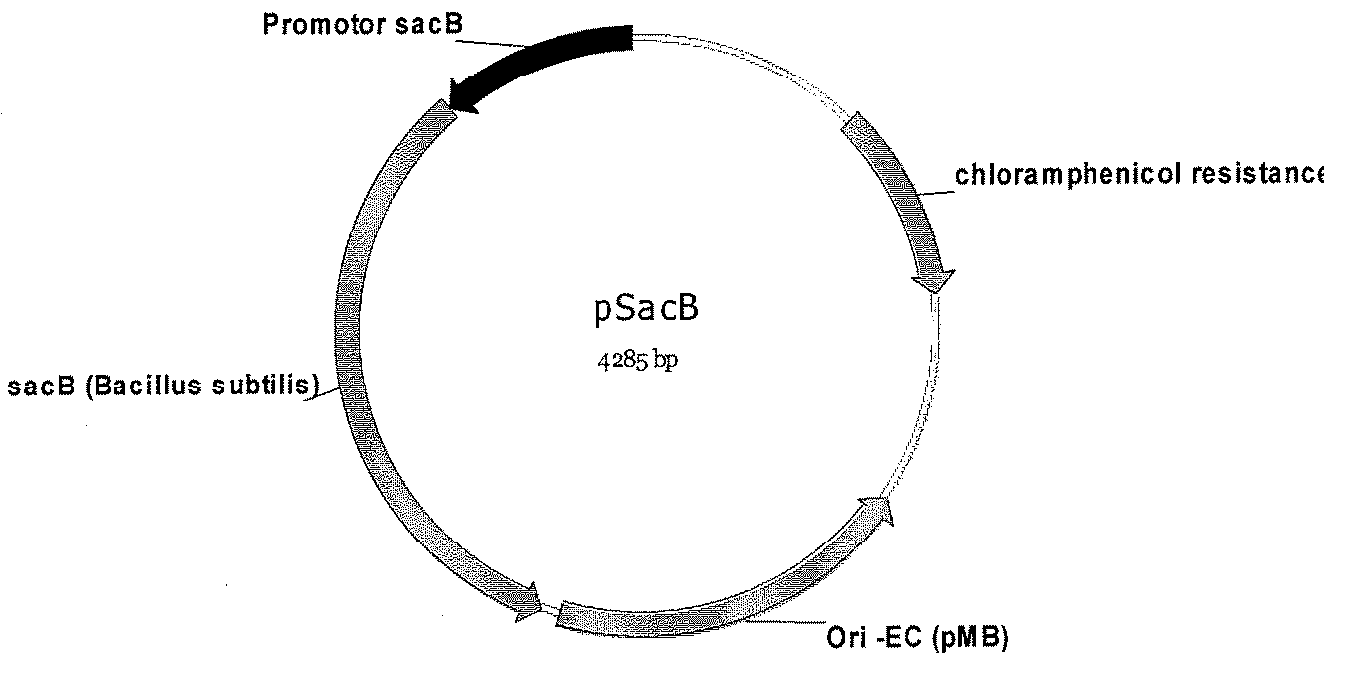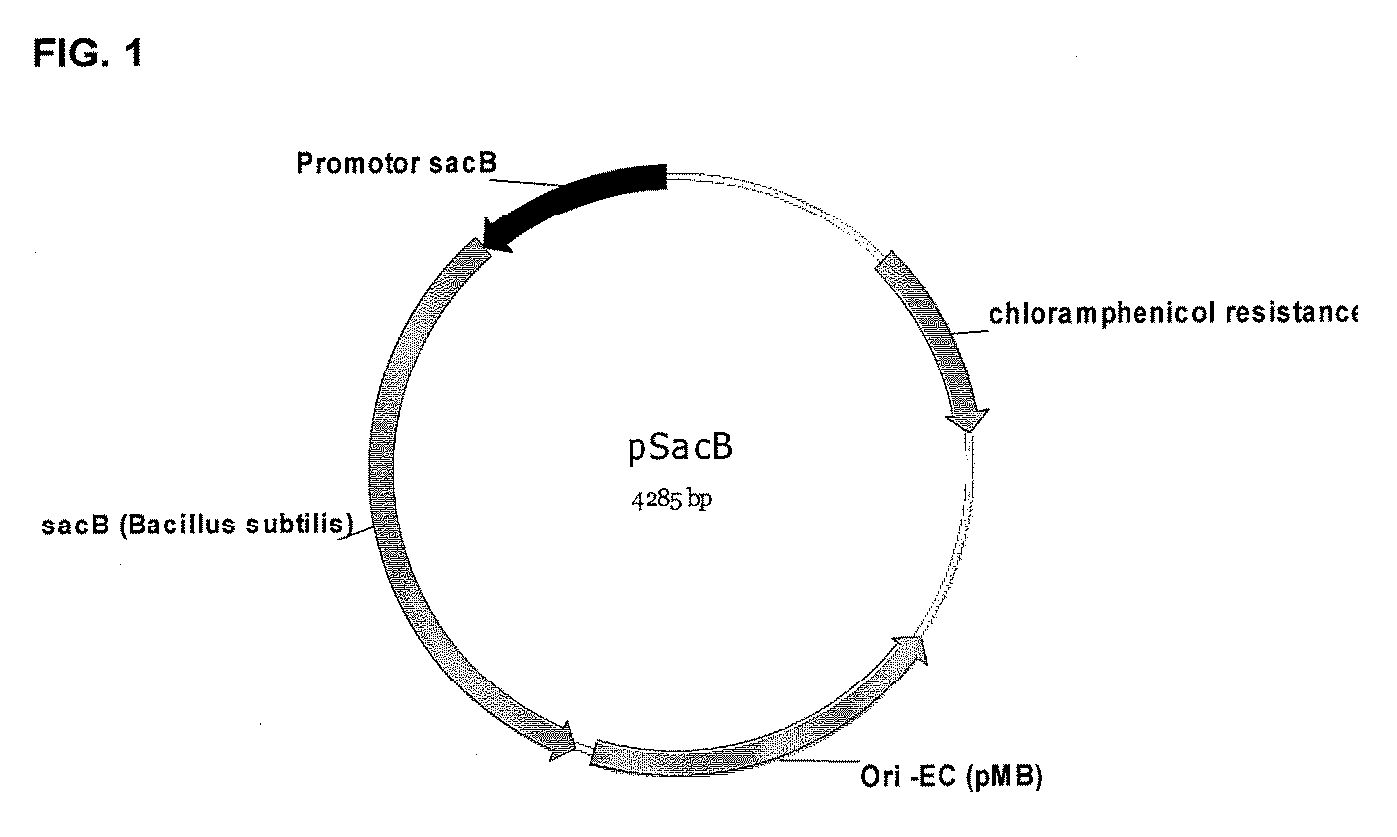Bacterial cells having a glyoxylate shunt for the manufacture of succinic acid
a technology of glyoxylate and bacteria, which is applied in the direction of lyase, enzymology, organic chemistry, etc., can solve the problem of inability to metabolize glycerol
- Summary
- Abstract
- Description
- Claims
- Application Information
AI Technical Summary
Benefits of technology
Problems solved by technology
Method used
Image
Examples
example 1
Transformation of DD1
[0135]
TABLE 1Nomenclature of the DD1 wildtype and mutants referred to inthe Examples.StrainDescriptionLU13843Wildtype DD1 (deposit DSM18541)LU15050DD1 delta ldhLU15224DD1 delta ldh pflDLU15224 pJFF224 (icl ms Y.m.)DD1 delta ldh pflD pJFF224(icl ms Y.m.)LU15224 pJFF224DD1 delta ldh pflD pJFF224LU13843 pJFF224DD1 pJFF224LU13843 pJFF224 (icl ms S.t.)DD1 pJFF224 (icl ms S.t.)LU 15050 pJFF224DD1 delta ldh pJFF224LU15050 pJFF224 (icl ms S.t.)DD1 delta ldh pJFF224(icl ms S.t.)LU 15050 pJFF224 (icl ms Y.m.)DD1 delta ldh pJFF224(icl ms Y.m.)LU 13843 pJFF224 (PpckA fdhDD1 pJFF224C.b.)(PpckA fdh C.b.)LU 15050 pJFF224 (PpckA fdhDD1 delta ldh pJFF224C.b.)(PpckA fdh C.b.)LU 13843 pJFF224 (PpckA fdhDD1 pJFF224 (PpckA fdh C.b.,C.b., PEFTU icl ms Y.m.)PEFTU icl ms Y.m.)LU15050 delta adhE.DD1 delta ldh delta adhELU15050 delta adhE. pJFF224DD1 delta ldh delta adhE pJFF224(PpckA fdh C.b.)(PpckA fdh C.b.)LU 13843 pJFF224 (fdh W.s.)DD1 pJFF224 (fdh W.s.)LU 15050 pJFF224 (fdh W.s.)DD1...
example 2
Generation of Deletion Constructs
[0149]Deletion plasmids were constructed based on the vector pSacB (SEQ ID NO 9). FIG. 1 shows a schematic map of plasmid pSacB. 5′- and 3′-flanking regions of the chromosomal fragment which should be deleted were amplified by PCR from chromosomal DNA of LU 13843 and introduced into the vector using standard techniques. Normally, at least 80% of the ORF were targeted for a deletion. In such a way, the deletion plasmids for lactate dehydrogenase ldhA, pSacB (delta ldhA), and for the pyruvate formate lyase pflD, pSacB (delta pflD) were constructed. FIGS. 2 and 3 show schematic maps of plasmid pSacB (delta ldhA) and pSacB (delta pflD).
example 3
Generation of Improved Succinate Producing Strains
[0150]LU 13843 was transformed as described above with the pSacB (delta ldh) and “Campbelled in” to yield a “Campbell in” strain. Transformation and integration into the genome of LU 13843 was confirmed by PCR yielding bands for the integrational event of the plasmid into the genome of LU 13843. The “Campbell in” strain was then “Campbelled out” using agar plates containing sucrose as a counter selection medium, selecting for the loss (of function) of the sacB gene. Therefore, the “Campbell in” strains were incubated in 25-35 ml of non selective medium (BHI containing no antibiotic) at 37° C., 220 rpm over night. The overnight culture was then streaked onto freshly prepared BHI containing sucrose plates (10%, no antibiotics) and incubated overnight at 37° C. (“first sucrose transfer”). Single colony obtained from first transfer were again streaked onto freshly prepared BHI containing sucrose plates (10%) and incubated overnight at 37...
PUM
| Property | Measurement | Unit |
|---|---|---|
| pH | aaaaa | aaaaa |
| temperature | aaaaa | aaaaa |
| temperature | aaaaa | aaaaa |
Abstract
Description
Claims
Application Information
 Login to View More
Login to View More - R&D
- Intellectual Property
- Life Sciences
- Materials
- Tech Scout
- Unparalleled Data Quality
- Higher Quality Content
- 60% Fewer Hallucinations
Browse by: Latest US Patents, China's latest patents, Technical Efficacy Thesaurus, Application Domain, Technology Topic, Popular Technical Reports.
© 2025 PatSnap. All rights reserved.Legal|Privacy policy|Modern Slavery Act Transparency Statement|Sitemap|About US| Contact US: help@patsnap.com



